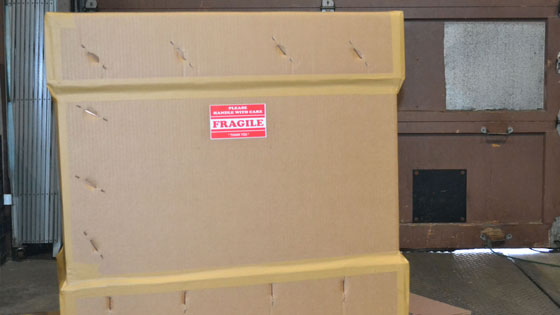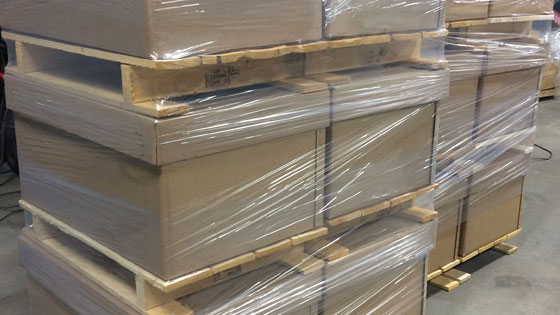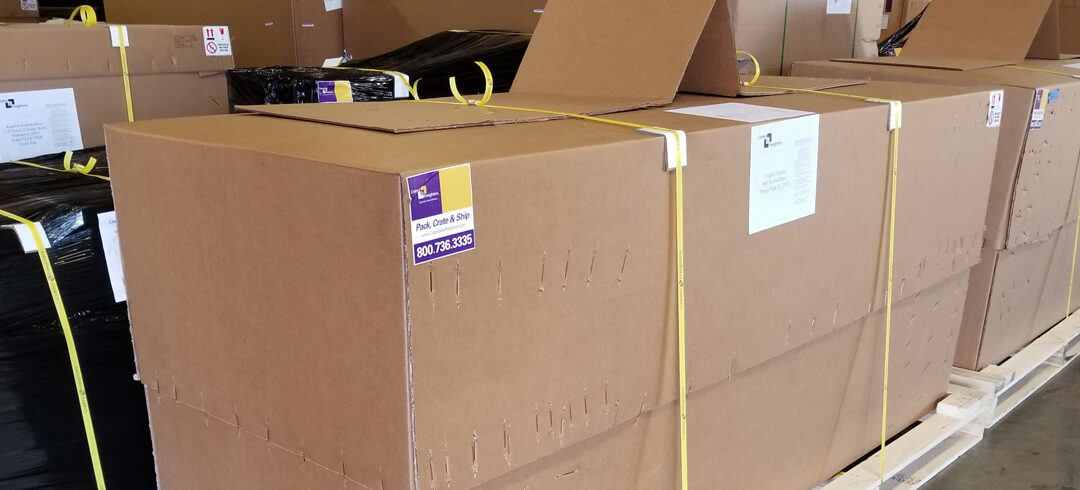Corrugated cardboard—sometimes called corrugated fiberboard—is material made of thick paper stock with a fluted (or grooved) middle layer surrounded by flat layers on either side. The result is sheets that are lightweight and surprisingly strong.
You know you’ve got corrugated cardboard if you look at the end of a sheet and see the characteristic center “wave” pattern that divides the space into separate cells. It’s those waves (and some complex physics) primarily that give corrugated its strength.
Ordinary cardboard, on the other hand, is simply thick paper stock. It offers little resistance to forces applied to it, and will bend or tear relatively easily. Cardboard does have its uses, of course. It’s ideal for notepad backing, food containers, and other applications. But when it comes to building shipping containers, corrugated cardboard is a must.
Advantages of Corrugated Cardboard in Specialty Packaging and Shipping
For some items and some shipping projects, a wooden crate is the best type of container. That determination is made based on the dimensions and weight of the items, their value, the mode(s) of transport that will be used and the final destination for the shipment. In many cases, however, corrugated cardboard can protect the items being shipped just as effectively and at a lower cost.
At Craters & Freighters, if a wooden crate isn’t necessary, we often use custom-manufactured corrugated cardboard shipping containers. Specifically, we build boxes with a minimum 350 lb. double-wall corrugated fiberboard that has three sheets of linerboard with two mediums or flutes in between. This double-thick material is incredibly strong and provides outstanding protection to the items in a box.

Frequently, we reinforce our corrugated boxes for added durability. This can be done in many ways, including strapping, banding and palletizing a box or boxes.
Whatever packaging strategy is used, corrugated cardboard boxes offer seven important benefits:
- They are strong. As noted above, corrugated cardboard’s layered design gives it tremendous strength. While not as strong as a wooden crate, a well-made corrugated box can withstand a great deal of force.
- They are lightweight. When it comes to the shipping and handling of containers, as long as the protection they provide is sufficient, the lighter the better.
- They are economical. Corrugated cardboard is a material that can be mass produced easily and consequently is very affordable.
- They are highly customizable. Corrugated cardboard boxes can be designed and built to meet any need. In the hands of the packaging engineers we have on staff, corrugated can be used to produce anything from a simple, square box to a one-of-a-kind structure perfectly suited to an odd-shaped item.
- They are reusable. Because they are so good at shrugging off the effects of shipping and handling, corrugated boxes can be used multiple times in many instances.
- They are recyclable. As Wikipedia notes about corrugated fiberboard, “Old corrugated containers are an excellent source of fiber for recycling. They can be compressed and baled for cost-effective transport. The baled boxes are put in a hydro pulper, which is a large vat of warm water for cleaning and processing. The pulp slurry is then used to make new paper and fiber products.”
- They can be broken down and stored. While corrugated boxes resist the random forces they encounter during shipping, they can be broken down intentionally for storage or transportation, particularly if they are designed with that intent in mind.
Beyond its use in constructing shipping containers, corrugated cardboard can be used to provide added protection and partitioning inside a container.

Cushioning and Other Protection in Specialty Packaging and Shipping
No type of container can protect the items within it if they are allowed to move around freely. That includes corrugated cardboard boxes. To augment the protection they provide, specialized cushioning must be added to the container.
Often this is in the form of polyethylene or polyurethane foams. The appropriate material is selected based on factors like density, shock value, drop, vibration and recovery characteristics. Certain blocking and bracing techniques may be used along with cushioning, as well.
The risk of electrostatic discharge damaging electronics is another consideration that can be addressed by using the appropriate packing materials. Anti-static wraps and cushioning can be utilized inside a corrugated cardboard shipping container to protect items like circuit boards, computer chips and electronic assemblies.
Also for electronics—and any item that can be damaged by corrosion—special vapor barrier packaging can be used to shield items that will be transported on a ship. “Bagging” items within their corrugated box, placing an activated desiccant within the vapor barrier bag, heat sealing the seams, and removing air from the bag with a vacuum device helps lower the humidity level and keep items from corroding.
Heat shrink wrapping is another way to protect assets during transport or while in storage. For items being shipped, the wrap prevents movement that can damage them. In outdoor storage situations, like at a construction site, heat shrink wrapping is an affordable option for providing defense against the elements.
And finally, in some instances, a container-within-a-container approach is recommended. For example, hard shell cases designed to cushion and protect items like sensitive equipment can be secured and then placed inside a corrugated cardboard container with additional cushioning for an added degree of protection.
Corrugated Cardboard: Strong, Durable and Versatile
While corrugated cardboard boxes aren’t as strong as wood crates, they shouldn’t be seen as inferior. They are simply made from a different type of material, and one that is ideally suited for a wide range of uses. Plus, because they are much lighter than a wooden crate, using them can often reduce shipping costs. Properly designed, constructed, and packed, a corrugated container provides exceptional performance and value.

